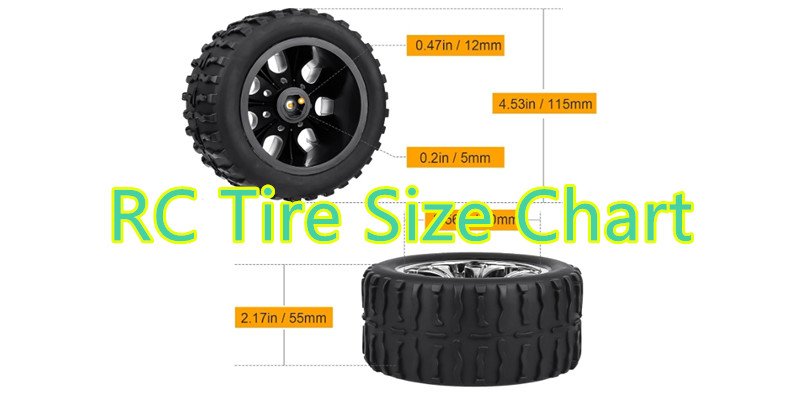Ultimate RC Tire Size Chart: Dimensions by Vehicle Type, Scale & Wheel Hex

Selecting the right tires transforms your RC experience—whether you’re scaling rocks with a crawler, hitting 70+ mph with a speed run car, or drifting through corners. Mismatched tires cause poor grip, accelerated wear, and even mechanical failure. This guide decodes tire sizing standards, compatibility matrices, and terrain-specific recommendations across 15+ RC vehicle types and 12 scales. Pair this with rollout calculations and hex charts to optimize speed, traction, and durability.
Decoding RC Tire Size Notations
RC tire dimensions use a standardized format: Section Width (in millimeters or inches), Aspect Ratio (sidewall height as % of width), and Wheel Diameter (in inches).
For example, a 120/80-17 tire is 120mm wide, with a sidewall height of 80% of width (96mm), fitting a 17-inch wheel.
Monster truck tires often simplify this to overall dimensions:
JConcepts Golden 73s: 4.4″ (112mm) wide × 7.3″ (185mm) tall.
Mickey Thompson Baja Claw TTC: 1.75″ (44.3mm) wide × 4.75″ (120mm) tall.
BFGoodrich KM3 RC Crawler Tire: 1.77″ (45mm) wide × 4.75″ (120mm) tall.
Key markings like “Tubeless,” load index (e.g., 61 = 257kg), and speed rating (e.g., P = 150km/h) appear on road tires. Crawler/truck tires prioritize compound softness (e.g., “X2S³” for grip).
RC Tire Size Chart by Vehicle Type
Different RC disciplines demand specialized tire dimensions for peak performance. Here’s the definitive breakdown:
| Vehicle Type | Tire Size Range | Terrain & Use Case |
|---|---|---|
| Rock Crawlers | 1.9″–2.2″ wheels; 100–130mm tall | Technical trails; prioritizes sidewall grip (e.g., Pro-Line Hyrax 1.0″ for SCX24) |
| Monster Trucks | 3.2″–4.0″ wheels; 150–185mm tall | Jumps/rough terrain; large volume for shock absorption (e.g., JConcepts Golden 73s @ 185mm) |
| Short Course (SCT) | 2.2″/3.0″ wheels; 110–125mm tall | Mixed dirt/pavement; block tread for slide control |
| Touring Cars | 60–70mm tall; low-profile | On-road precision; slicks or minimal tread |
| Buggies | 1/10: 80–87mm; 1/8: 100–120mm | Track racing; balanced diameter for acceleration/jumping |
| Truggies | 1/8 scale: 120–140mm tall | Hybrid buggy/truck; taller than buggies for bump absorption |
| Stadium Trucks | Front: 80–90mm; Rear: 90–100mm | High-speed off-road; narrower front for steering response |
| Drift Cars | 60–70mm; hard compound | Pavement; minimal tread + high slip angle |
| Drag Cars | Slick tires; 90–110mm (1/10 scale) | Acceleration-focused; minimal rollout |
| Desert Trucks | 120–150mm tall; chunky tread | Soft sand; paddle-like lugs for flotation |
| Formula 1 | Foam tires; 65–75mm | Smooth surfaces; ultra-low profile for downforce |
| Motorcycles | Narrow front (45mm); wide rear (60mm) | Lean-sensitive; ribbed front tire |
Critical Note: On-road vehicles (e.g., Touring, Formula 1) often include speed ratings (e.g., “Y” = 186 mph) and load indexes (e.g., 94 = 670kg), while off-road tires emphasize durometer (e.g., “40A” soft compound).
RC Tire Size Chart by Scale
Scale directly dictates tire dimensions. Always match wheel hex size to avoid wobbling or detachment:
| RC Scale | Tire Diameter | Typical Hex Size | Example Models |
|---|---|---|---|
| 1/28–1/24 | 47–68mm | 7mm | SCX24 (Pro-Line Hyrax: 53.3mm) |
| 1/18–1/16 | 58–83mm | 8mm/12mm | RC18B (58.5mm), Mini E-Revo (83mm) |
| 1/14 | 75–80mm | 12mm | Losi Mini 8ight (75mm) |
| 1/12 | Foam tires; 45–55mm | 11mm (pan cars) | CRC Gen-Xi (rollout ~45mm) |
| 1/10 | 70–125mm | 12mm (standard) | Traxxas Slash (110mm), Axial SCX10 (120mm) |
| 1/8–1/7 | 100–170mm | 17mm | Arrma Kraton (150mm) |
| 1/6–1/5 | 180–220mm | 20mm/24mm | Losi 5IVE-T (200mm) |
Scale Reference: Confused about scale realism? Decoding RC Car Scales explains size-to-performance tradeoffs.
RC Tire & Wheel Hex Size Compatibility Chart
The wheel hex size—the adapter slot connecting wheels to axles—must match precisely. Mismatches cause vibration or crashes:
| Hex Size | Common Applications | Tire Examples |
|---|---|---|
| 7mm | 1/24 crawlers (SCX24), Colt 1/16 LYNX | Pro-Line Hyrax 1.0″ (53.3mm) |
| 8mm | 1/18 buggies (RC18B), HPI Minizilla | Rosi Desert Buggy (60mm) |
| 12mm | 1/10–1/8 vehicles (standard) | Pro-Line Badlands (125mm SCT) |
| 14mm | Large-scale MTs, some 1/8 buggies | GRP S7 Speed Run Tires (100mm) |
| 17mm | 1/7–1/8 truggies, Arrma 6S models | dBoots Katars (150mm) |
| 20mm/24mm | 1/5 scale (Losi DBXL, Kraken Vekta) | Vitavon Tarmac (220mm) |
Warning: Never force a 12mm wheel onto a 14mm hex! Use adapters (e.g., 12mm→17mm) for cross-compatibility.
How Tires and Wheels Interact: Critical Relationships
- Wheel Diameter (e.g., 1.9″, 2.2″) must match the tire’s inner diameter (e.g., 48mm for 1.9″ tires).
- Wheel Width (e.g., 8Jx18) affects tire shape: Narrow wheels stretch tires; wide wheels flatten treads.
- Offset (ET) determines stance: High ET values tuck wheels inward; low ET pushes them out for stability.
- Load Index/Speed Rating: Critical for road RC cars (e.g., 61P = 257kg load, 150km/h max).
- Rollout Calculation:
Rollout = π × Tire Diameter × (Pinion Teeth / Spur Teeth)
Example: A 100mm tire with 20T pinion and 80T spur yields:3.14 × 100 × (20/80) = 78.5mm/revolution.
Optimize gearing using RC Car Gearing Charts: The Ultimate Guide.
Key Takeaways for Selecting RC Tires
- Prioritize scale and vehicle type – A 1/10 crawler needs 110–120mm tires 8, while 1/8 buggies require 100–120mm.
- Match hex sizes exactly – A 12mm hex wheel won’t fit an 8mm axle without adapters.
- Consider terrain: Soft “blue compound” (e.g., Golden 73s) grips rocks/dirt ; hard compounds last longer on pavement.
- Calculate rollout: Use RC gearing calculators factoring tire height for speed tuning .
Tips: For vintage monster trucks (e.g., Clod Buster), JConcepts’ 7.3″ Golden 73s on #3439 wheels deliver authentic 1980s crushing performance. Always verify bead diameter compatibility!
By cross-referencing these charts with your RC’s specs, you’ll optimize grip, speed, and scale realism. When in doubt, consult your vehicle manual or manufacturer hex/tire databases.